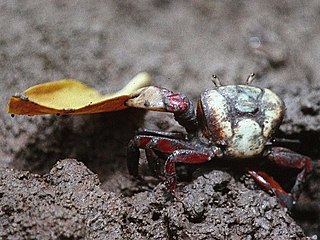
Royal Botanic Gardens, Kew, is a non-departmental public body in the United Kingdom sponsored by the Department for Environment, Food and Rural Affairs. An internationally important botanical research and education institution, it employs 1,100 staff. Its board of trustees is chaired by Dame Amelia Fawcett.

Schefflera is a genus of flowering plants in the family Araliaceae. With an estimated 600–900 species, the genus represents about half of its family. The plants are trees, shrubs or lianas, growing 4–20 metres (13–66 ft) tall, with woody stems, the absence of articulated pedicels and armaments, and palmately compound leaves.

Streptanthus is a genus of plants within the family Brassicaceae. There are about 35 known species within the genus Streptanthus, distributed mostly throughout western North America. The common names for this genus are twistflower and jewelflower. Twenty-four of the species and eleven lesser taxa occur in California, thirty-two of which are California endemics; seventeen of these California taxa are classified as rare plants.

Schefflera morototoni is a timber tree native to southern Mexico, the Greater Antilles, Central America, and South America. It grows in a variety of habitats, such as the Caatinga, Cerrado, and Amazon Rainforest of Brazil.
Podocarpus hispaniolensis is a species of conifer in the family Podocarpaceae. It is endemic to the Dominican Republic.
Shorea cordata is a species of plant in the family Dipterocarpaceae. The species name cordata is derived from Latin and refers to the shape of the leaf base.
Styrax cordatus is a species of plant in the family Styracaceae. It is native to Peru and Ecuador.
Blakeanthus is a genus of flowering plants in the daisy family, Asteraceae.
Hylebates is a genus of African plants in the grass family.

Streptanthus cordatus is a species of flowering plant in the mustard family known by the common name heartleaf twistflower. It is native to the western United States, where it can be found in many types of sagebrush, woodland, and forest habitat. It is a perennial herb producing a branched or unbranched stem up to about a meter tall. It is often waxy in texture. The basal leaves are oval or spoon-shaped with bristle-toothed blades borne on rough-haired petioles. Leaves higher on the stem are oval to lance-shaped, up to 9 centimeters long with their bases usually clasping the stem. Flowers occur at intervals along the upper stem. Each has a calyx of sepals roughly a centimeter long which begin greenish yellow and mature purple. Four purple petals emerge from the tip of each calyx. The fruit is a thin, narrow silique which may reach 14 centimeters in length or longer.
The Plant List is a list of botanical names of species of plants created by the Royal Botanic Gardens, Kew and the Missouri Botanical Garden and launched in 2010. It was intended to be a comprehensive record of all known names of plant species over time, and was produced in response to Target 1 of the 2002-2010 Global Strategy for Plant Conservation, to produce "An online flora of all known plants.” It has not been updated since 2013, and is superseded by World Flora Online.

Ucides cordatus, the swamp ghost crab, is one of two species of crabs in the genus Ucides. This species of crab is native to many coasts off of the western Atlantic Ocean. It has been found to be native to areas as far as Florida, to as southern as Uruguay. U. cordatus is especially noteworthy in the country in Brazil as it plays important roles in the economy and food resources at Brazil’s Atlantic borders.

Abatus cordatus is a species of sea urchin in the family Schizasteridae. It is native to shallow seas surrounding certain island groups in the southern Indian Ocean. The body is protected by a hard test or shell which is covered with spines. The female broods its young in deep pockets on the upper surface, retaining the young in place with specialised spines. American zoologist Addison Emery Verrill first scientifically described A. cordatus in 1876.

Evolvulus is a genus of flowering plants in the Convolvulaceae, the morning glory family. They are known generally as dwarf morning glories. Most all are native to the Americas. There are about 100 species.
The World Checklist of Selected Plant Families is an "international collaborative programme that provides the latest peer reviewed and published opinions on the accepted scientific names and synonyms of selected plant families." Maintained by the Royal Botanic Gardens, Kew, it is available online, allowing searches for the names of families, genera and species, as well as the ability to create checklists.

Hemidesmus is a genus of plants in the Apocynaceae, first described in 1810. It is native to the Indian Subcontinent.
- Hemidesmus cordatus(Poir.) Schult. - India
- Hemidesmus indicus(L.) R. Br. ex Schult. - Pakistan, India, Bangladesh
- Hemidesmus indicus var. pubescensHook.f., syn of Finlaysonia wallichii(Wight) Venter
- Hemidesmus pubescensWight & Arn., syn of Finlaysonia wallichii(Wight) Venter
- Hemidesmus wallichiiWight, syn of Finlaysonia wallichii(Wight) Venter
Plants of the World Online is an online database published by the Royal Botanic Gardens, Kew. It was launched in March 2017 with the ultimate aim being "to enable users to access information on all the world's known seed-bearing plants by 2020". The initial focus was on tropical African Floras, particularly Flora Zambesiaca, Flora of West Tropical Africa and Flora of Tropical East Africa.

Psittacanthus cordatus is a species of Neotropical mistletoe in the family Loranthaceae, which is native to Bolivia and Brazil.

World Flora Online is an Internet-based compendium of the world’s plant species.

Leucopogon cordatus is a small plant in the family Ericaceae, endemic to Western Australia. It is an erect spreading shrub, growing from 0.35 m to 1 m high, on sandy soils often over granite laterite or limestone. Its white flowers may be seen from July to November.











